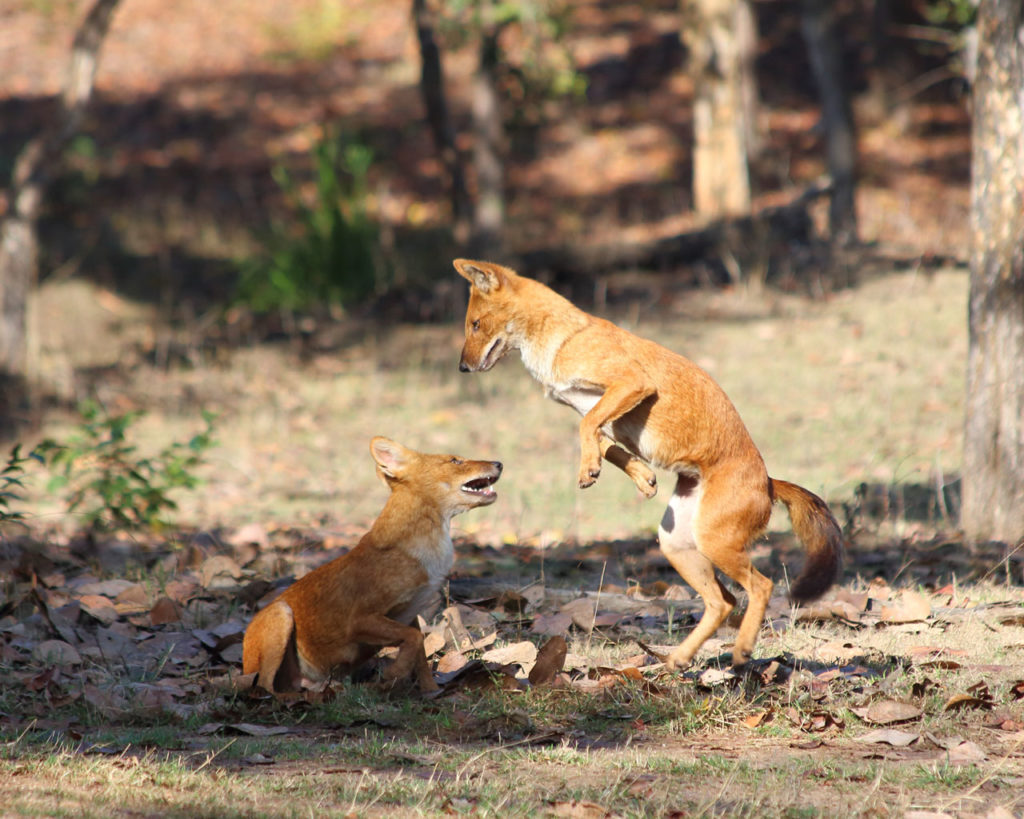A new study led by scientists from Wildlife Conservation Society-India Program, Centre for Wildlife Studies (Bangalore), and University of Florida, USA, presents the first home-range size estimate of Asiatic wild dogs or ‘dholes’ based on camera trap surveys.

- Image via wikimedia
The study, based on intensive camera-trap surveys conducted in Nagarahole and Wayanad wildlife reserves in the Western Ghats India, was part of a long-term project on tiger population dynamics in the region. The researchers found the Dhole home range to be approximately 85 sq.km based on their method.
Lead author of the study Arjun Srivathsa, who is a doctoral student at the University of Florida says,
“Typically, radio-telemetry is used to obtain information on home-range sizes of large carnivores such as dhole. This is expensive and requires careful handling of animals. In contrast, our estimates are generated through innovative use of non-invasive and relatively inexpensive camera-trap pictures”.
From November 2014 to January 2015 (45 days), the researchers set-up and monitored camera traps which yielded incidental photographic captures of dholes. Unlike tigers or leopards, individual dholes cannot be uniquely identified from camera-trap photographs because they do not have pelage patterns or natural body markings. However, the researchers could identify two wild dogs with unique markings helping them track and map them during the survey.
In the 45 days when camera traps were laid in the area to study large mammals, the researchers observed the marked dholes and their pack from time to time. Based on their sightings, they mapped an approximate area of 85 sq. km of the Dholes in the Western Ghats. This is higher than previous estimates done in 1982, 1995 and 2005.
The researchers say in their paper,
“Home-range size in dholes may vary as a function of densities of prey species, and possibly other habitat characteristics, as well as pack size. For example, dholes in central India have large annual home-ranges, between 40–200km2, generally showing seasonal variations.”
They further add,
“In the central part of Western Ghats (our study area), dhole packs appear to have much smaller home-range sizes (seasonally 20– 60km2; Johnsingh 1982, Venkataraman et al. 1995, Karanth and Sunquist 2000), a likely consequence of high densities of ungulate prey in these well-protected deciduous forest reserves. Our estimate presented here is much larger compared to that reported by Karanth and Sunquist (2000), who estimated home-range size of ~27km2 for a pack of dholes from an adjacent area in Nagarahole between 1988-1991. This is probably an underestimate, because their study relied completely on opportunistic sightings of the pack.”
Read More: Wild Dogs And Wild Cats Of India Chose To Coexist Rather Than Compete
New Use Of Camera Traps
There are 900-2,100 mature dholes surviving globally. Despite being listed as ‘Endangered’ on the IUCN Red List, dholes remain one of the least studied species among large, social carnivores. This could also be because of the fact that they are difficult to capture, radio-collar or track because of their movement behavior. Without unique markings, it also becomes challenging to identify individual dholes.
Considering the challenges, the present study has therefore found a way to track dholes in a non-invasive way using camera traps. The researchers do add that this survey was conducted for a brief period only and therefore cannot provide the annual range estimate of the wild dogs. Nonetheless, it opens a new way of safely observing a less researched Indian species.
The study appears in the January issue of the international journal Canid Biology and Conservation. Authors: Arjun Srivathsa (Centre for Wildlife Studies, Wildlife Conservation Society-India Program and University of Florida, USA), Dr. N. Samba Kumar (Centre for Wildlife Studies and Wildlife Conservation Society-India Program) and Dr. K. Ullas Karanth (Centre for Wildlife Studies, India and Wildlife Conservation Society, New York). It is accessible online at: http://www.canids.org/CBC/20/Dhole_home_range.pdf
Read More: Rare Asiatic Wild Dog Spotted In Bengal For The First Time








